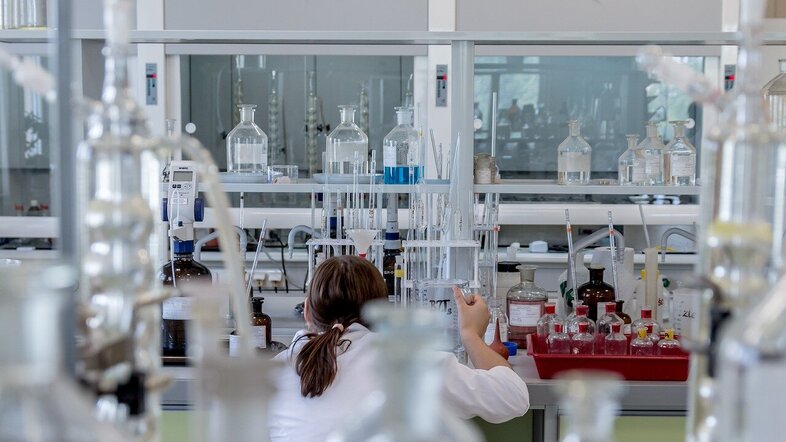"It smells of Vienna"
"Sausage stand", "Danube water", "ciggy", "rose garden" – what does Vienna smell of? If we asked a hundred people this question, we would probably get a hundred different answers. The reason for this: “Smells reach the limbic system in our brain directly via the amygdala. Unlike all other sensory signals, they are not first sent through the thalamus to the cerebral cortex for processing. Emotions and personal memories are therefore often directly and closely connected to our olfactory experiences,” explains historian Julia Gebke, who collected the personal olfactory stories of Vienna’s people as part of the citizen science project 'Wien der Nase nach’ (follow your nose through Vienna) led by Stephanie Weismann. If you want to get an impression of the project, explore the ‘map of Vienna smells’ (Geruchskarte) created as part of the project and add your personal Vienna smell.
Distinct smells in Ottakring
Having a look at the map of "Vienna smells", we notice how packed the green dots, representing positive assessments of smells, are in the Ottakring district. “The Ottakringer Brewery and the Manner factory fill the Ottakring district with two very different industrial smells, which, however, have a positive connotation for many people,” says Gebke. “When talking about the special ability of smells to evoke memories, many people in Vienna often spontaneously think of Ottakring. When smells evoke memories of the past, we call this the Proust effect, named after author Marcel Proust, who vividly described this trigger effect in a scene in his novel In Search of Lost Time.”
The composition of Vienna’s air
Using high-tech devices, aerosol physicist Bernadett Weinzierl is able to precisely identify the components of Vienna’s air, starting at a particle size of merely a few nanometres. This allows her to clarify pressing questions regarding air-borne particles, such as microplastics, mineral dust or soot. The researcher takes us on a mental smell walk through, of course, Ottakring and its surrounding neighbourhoods. Our tour begins in the Vienna Alsergrund district, where we find a state-of-the-art aerosol observatory on the roof of the Faculty of Physics of the University of Vienna at 35 metres above ground level. “Here, we measure tiny particles in the air,” explains Bernadett Weinzierl, gazing out over Vienna. Apart from the Vienna General Hospital (AKH), there is no higher building than the Faculty in the vicinity. “We get air from all directions here, the perfect location for our measurements,” says the aerosol physicist.
Tracing olfactory stories
Smell walks as well as creative writing methods can allow us to access deeply buried worlds of smell, explains Julia Gebke, who led the Sniff’n Write sessions of the ‘Wien der Nase nach’ project. Workshop participants were invited to put pen to paper to describe their olfactory experiences, which “took us to the heart of the matter: Again and again, we noticed how limited our smell-related vocabulary is and how often we had to rely on other vocabulary, for example, on words relating to taste. But especially free writing and lyrical forms such as the elevenie and pantun (editors’ note: You can find further information about creative writing and a brief guide to try it yourself here [in German]), helped participants bring to light exciting results.”
History of smells for future generations
Gebke is actually an expert on the early modern period, that is the period from AD 1,500 to AD 1,800. People at the time often found it important to keep records of notable events, which we can use for source-based research today, says Gebke. But for historians like Gebke, everyday things, emotions, recollections or smells are just as fascinating because they can help us understand how people lived and what they thought in a certain period. “The ‘Wien der Nase nach’ project enabled me to do something that is usually not part of my area of responsibility”, smirks Gebke, “I was able to contribute to the creation of fascinating source material about everyday life in Vienna in the 21st century for future historians.”
Breathe in?
The collection of data for future generations is complemented by Bernadett Weinzierl and her research on aerosols, suspensions of tiny particles in gas (e.g. air), which are subject to constant changes. The tiny little aerosol particles are not exactly determining factors of smell, but they often come along with it: “When a smell tickles our senses, we often see an increased concentration of aerosol particles, for example, on an extremely busy road,” explains the professor of the Faculty of Physics. This is our cue: We are off to the Gürtel beltway, where cars are speeding by one after another. Bernadett Weinzierl, should we take a deep breath here – or had we better not?
Come along on our Summer City Trip!
Fancy going on a smell walk yourself? You do not have to go to a special place to take a whiff of Vienna. All you need to do is wander the city with your nostrils open, says Julia Gebke. She recommends to consciously take in the smells you encounter on your way to work or in your free time. If you want to explore the iconic smells of Ottakring, you can simply trace our route. Feel free to enter the smells you encounter in the map of Vienna smells created as part of the ‘Wien der Nase nach’ project – thank you for your data donation!
- Kongresspark: Green is good for us – and for the air! Human-made aerosol particles deposit on the leaves and needles of trees and plants. This is how they are filtered from the air.
- Manner factory: Chocolate is in the air. Many people associate the special smell of the Manner factory with personal memories – the Proust effect. What comes to your mind when you smell the scent of roasted cocoa in the area around the Manner factory?
- Drugstore: The automatic door slides open and the scent of perfumes, soaps and creams fills the air outside the store. We are passing a drugstore – gases tickle our sense of smell in front of the store.
- Gürtel beltway: The odour of sausages, doner kebab and falafel is mixing with exhaust fumes. We have reached the Gürtel beltway road. The compulsory filters for motor vehicles have reduced the amount of soot in the air here compared to 60 years ago – the Gürtel beltway thus beats many port cities when it comes to clean air.
How to get the GPS track:
Download the GPX file below to your smartphone and import it into the navigation app of your choice, such as Komoot. Here you can find instructions for importing it into Komoot.
Suggested route for your Summer City Trip through Vienna
Exhale!
So-called PM2.5 particulate matter, i.e. particles with a diameter of 2.5 micrometres (µm) or less, e.g. from traffic emissions, as well as low-level ozone are still some of the major air pollutants. But there is good news as well: The Faculty of Physics has been collecting data for more than 60 years and the soot concentration in Vienna’s air has decreased by 70 per cent in the summer and by around 88 per cent in the winter since the beginning of the 1980s. This is due to air quality control measures, such as the use of particulate filters in diesel engines and in the industry as well as modern heating systems, suspects Weinzierl.
“This is a very positive development, since we know that soot is harmful to our health,” explains the expert, “There is a relation between the concentration of particulate matter in the air and premature deaths. A very recent study has shown that around 135 million people have died prematurely due to particulate matter in the past 40 years. However, the air quality in Europe has significantly improved in the past decades and the number of premature deaths due to air pollution continues to decrease.”
What is ‘good air’?
Defining what ‘good air’ actually means is not that easy, not even for an aerosol physicist. Bernadett Weinzierl gives it a shot and takes us on a mental journey to the Kongresspark, a green, forested park in Ottakring district, covering 61,000 m². “An increased concentration of particles in the air does not necessarily constitute a health hazard. The material and size of the particles are decisive: Coarse particles with a diameter of a few micrometres are filtered by our nose, but smaller particles may pose a danger; ultra-fine particles (< 0.1 µm) can enter the depths of our lungs, deposit there or even pass into the blood stream, which can cause cardiovascular and respiratory diseases.
Trees in forests and parks, such as in the Kongresspark in Ottakring, provide shade, evaporate water and thus cool the area during the day. Moreover, the large surface of the trees’ leaves and needles provides a place where aerosol particles can deposit. They are filtered from the air in this way. However, some types of trees, such as oaks and poplars, emit large amounts of isoprene – especially at warmer temperatures – from which aerosol particles can form,” explains Weinzierl. Even though isoprene is not fundamentally bad, chemical reactions with nitrogen oxides, e.g. from cars or coal-fired power plants, can increase air pollution by producing ground-level ozone, to which around ten to 15 per cent of the population is sensitive.
“What we tend to forget in the debate on air quality: The particulate pollution indoors is often higher than outdoors. Smoke, mould, chemicals contained in colours, furniture or cleaning agents can affect the air quality indoors. The particulate matter accumulates if we do not regularly ventilate our rooms,” warns the physicist.
Human-made emissions are stinking to high heaven
20 years ago, Weinzierl and her colleagues measured the exhaust gases emitted by ships – detecting high concentrations of particulate matter, especially around the English Channel. In January 2020, new legal regulations to limit emissions in shipping entered into force, requiring ships worldwide to use only low-sulphur fuel. This has also significantly reduced the cooling sulphate aerosol particles in shipping – which is good for air quality but paradoxically aggravates global warming.
From a global perspective, aerosol particles have a cooling effect on our climate and alleviate global warming caused by greenhouse gases, especially carbon dioxide and methane. The particles reflect the sunlight back into space, affect cloud formation and make clouds brighter – which means that they can also reflect more sunlight. “Without human-made particle emissions, global warming caused by humans would have been around 0.5 degrees higher compared to pre-industrial times around 1750,” says Weinzierl, “So, air quality management does not equal climate action. From a health perspective, however, any reduction in air pollution is welcome – even if it makes the global warming caused by human greenhouse gases more visible. Ultimately, we have to solve the actual problem and reduce our greenhouse gas emissions.”
Experience chemistry with all your senses
How important is chemical research for our daily lives? And how does it help us to overcome current social challenges? In the "Chemistry of the Senses" project led by Nuno Maulide, chemistry is brought to life through the five human senses. If you want to find out more, you've come to the right place: to the project website (in German).
The cooling effect of aerosol particles is already being tested in field studies in Australia, for example. However, it is not soot but seawater droplets that are sprayed over the Great Barrier Reef to create artificial clouds and/or to brighten existing clouds. “We have to be cautious with such interferences with natural cycles to ensure that we do not produce unwanted side effects. I used to be very critical of so-called geoengineering, but we cannot turn a blind eye in view of the ever-increasing global warming. Reputable scientists have to better understand atmospheric processes and explore geoengineering in models to be able to better quantify the risks as well as the possible negative impact of geoengineering.” Maybe this will help us to not only collect stories for the generations to come, but also to rewrite history for the generations to come. (hm)
She conducts her research on the composition of air not only in the state-of-the-art aerosol observatory on the rooftop of the Faculty of Physics but also on research planes. Her absolutely favourite summer scent: Lavender – it blossoms in rich and purple-green colours on her balcony garden in Vienna.
She was responsible for the Sniff’n Write workshops as a writing trainer in the ‘Wien der Nase nach’ project, enabling workshop participants to bring back one or the other olfactory memory. The smell of wild garlic – “the typical mixture of cool, earthy, wet and garlic smells” – instantly takes her to the Liesingbach brook and reminds her of weekend hikes through the forested edges of Vienna.


